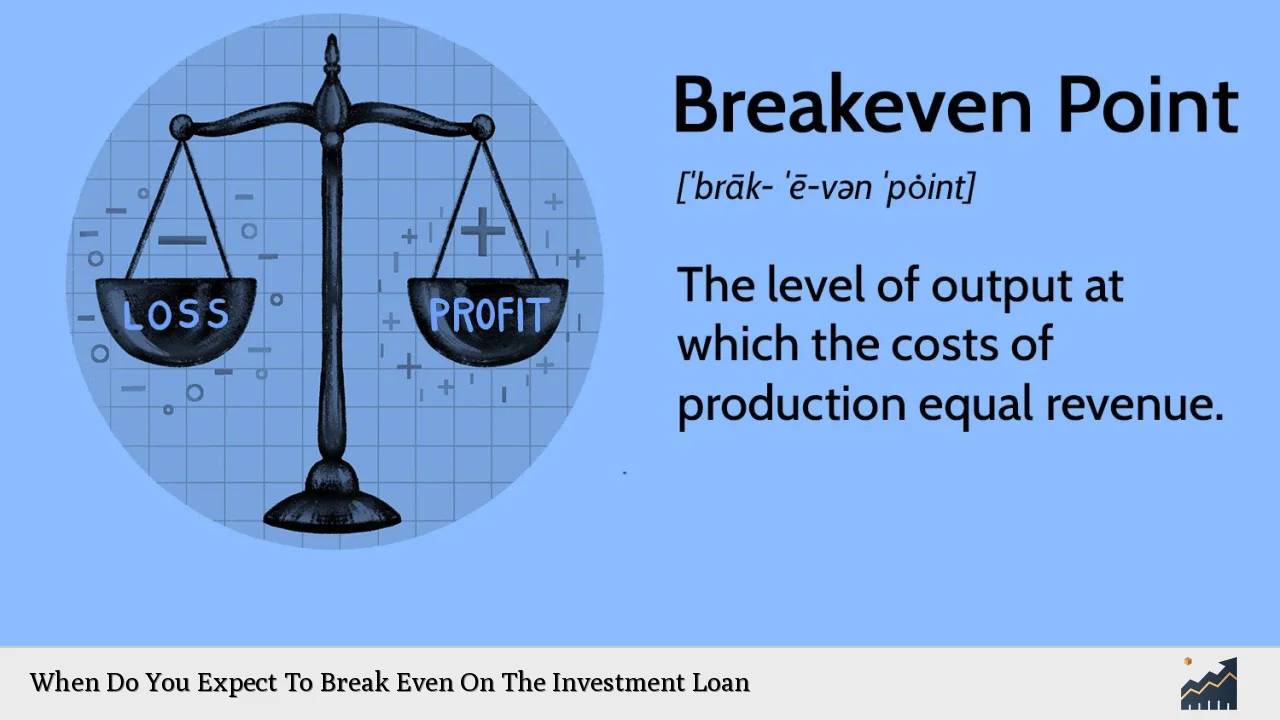Understanding when you can expect to break even on an investment loan is crucial for both individual investors and finance professionals. This analysis not only helps in assessing the viability of an investment but also aids in strategic financial planning. Breaking even refers to the point at which total revenues equal total costs, meaning that an investor has recouped their initial investment and is no longer operating at a loss. This concept is particularly relevant in various investment scenarios, including real estate, business acquisitions, and other capital-intensive ventures.
To calculate the break-even point for an investment loan, several factors must be considered, including the initial investment amount, loan interest rates, cash flow from the investment, and ongoing expenses.
| Key Concept | Description/Impact |
|---|---|
| Initial Investment | The total amount of money invested in the asset or business. |
| Gross Revenue | The total income generated from the investment before any expenses are deducted. |
| Total Expenses | All costs associated with maintaining the investment, including operational costs. |
| Interest Expense | The cost of borrowing money, which affects overall profitability. |
| Taxes Paid | Government taxes that reduce net income from the investment. |
| Cash Flow Analysis | A method to analyze the inflows and outflows of cash to determine profitability. |
Market Analysis and Trends
The current market landscape plays a significant role in determining break-even timelines for investment loans. As of late 2024, interest rates have shown a downward trend due to economic adjustments aimed at stimulating growth. For instance, recent reports indicate that the average interest rate for new loans has decreased, making borrowing cheaper and potentially shortening break-even periods for investors.
Moreover, sectors such as real estate are experiencing varying levels of demand. In September 2024, new loan commitments for housing fell slightly by 0.3%, while personal fixed-term loans increased by 2.1%. This fluctuation indicates that while some markets may be contracting, others are expanding, reflecting a diverse landscape where investors must carefully assess their specific conditions.
Current Economic Indicators
- Interest Rates: The Federal Reserve’s policies have led to lower borrowing costs.
- Loan Demand: Increased demand for loans in personal finance sectors suggests a robust market.
- Inflation Rates: Moderate inflation can erode purchasing power but also drive asset appreciation.
Implementation Strategies
To effectively manage investments and break-even timelines, investors should consider the following strategies:
- Thorough Market Research: Understanding local market conditions can help identify optimal investment opportunities.
- Financial Projections: Utilize detailed financial modeling to predict cash flows and adjust strategies accordingly.
- Cost Management: Implementing strict cost controls can enhance profitability and shorten break-even periods.
- Diversification: Spreading investments across different asset classes can mitigate risks associated with individual investments.
Risk Considerations
Investing inherently carries risks that can affect the break-even timeline:
- Market Risk: Fluctuations in market conditions can impact revenue generation.
- Credit Risk: The risk of borrower defaults can affect cash flows if investing in loans.
- Operational Risk: Inefficiencies in managing assets can lead to increased costs and delayed profitability.
Investors should conduct comprehensive risk assessments to understand how these factors may influence their specific break-even scenarios.
Regulatory Aspects
Understanding regulatory requirements is crucial for ensuring compliance and optimizing financial performance:
- Loan Regulations: Familiarity with lending laws and regulations can help avoid legal pitfalls.
- Tax Implications: Knowledge of tax obligations related to investments influences net income calculations.
- Reporting Standards: Adhering to financial reporting standards ensures transparency and accuracy in financial assessments.
Future Outlook
Looking ahead, several trends are likely to influence when investors can expect to break even on their loans:
- Technological Advancements: Innovations in financial technology could streamline processes and reduce costs associated with managing investments.
- Sustainability Focus: Growing emphasis on environmental, social, and governance (ESG) criteria may shape future investment decisions and valuations.
- Global Economic Conditions: Ongoing geopolitical developments will continue to impact interest rates and overall market stability.
As economic conditions evolve, investors must remain agile and adapt their strategies accordingly to optimize their chances of achieving timely returns on their investments.
Frequently Asked Questions About When Do You Expect To Break Even On The Investment Loan
- What factors influence my break-even point?
Factors include initial investment size, interest rates on loans, gross revenue from the investment, total expenses incurred, and tax obligations. - How can I calculate my expected break-even time?
You can use the formula: Break-even point (in years) = Total Cash Investment / Annual Net Cash Flow. - What is considered a good break-even period?
A standard break-even period typically ranges from 6 months to 2 years depending on the type of investment. - How do interest rates affect my break-even analysis?
Lower interest rates reduce your overall expenses related to borrowing, which can shorten your break-even period. - What should I do if my break-even point is too long?
You might consider increasing revenue through pricing strategies or reducing costs through operational efficiencies. - Is it necessary to consult a financial advisor for this analysis?
While it’s possible to conduct your own analysis, consulting a financial advisor can provide valuable insights tailored to your specific situation. - Can market conditions change my break-even expectations?
Yes, shifts in market demand or economic indicators can significantly impact your expected revenues and expenses. - What role does cash flow play in achieving my break-even point?
Positive cash flow is essential as it directly contributes to covering your initial investment and ongoing expenses.
In conclusion, understanding when you will break even on an investment loan requires careful analysis of various financial metrics and market conditions. By employing sound strategies and remaining informed about economic trends, investors can enhance their chances of achieving timely returns on their investments.

